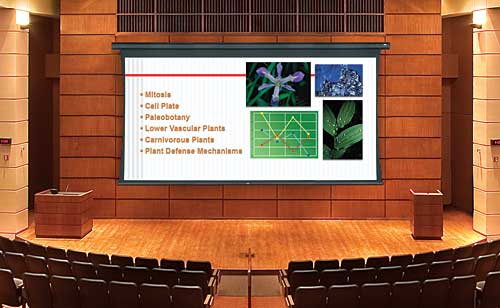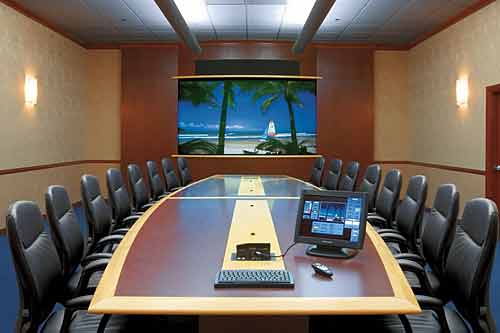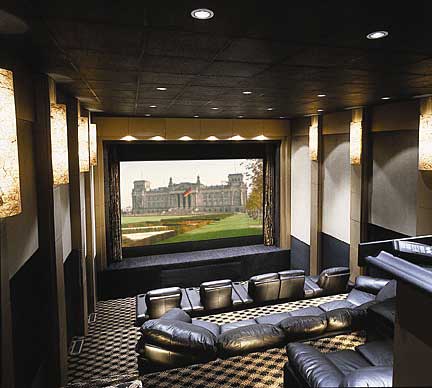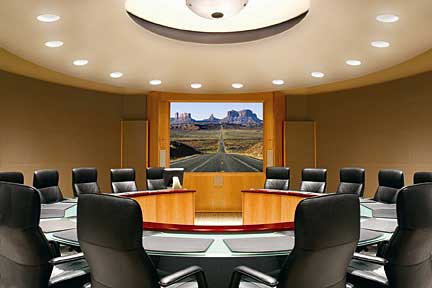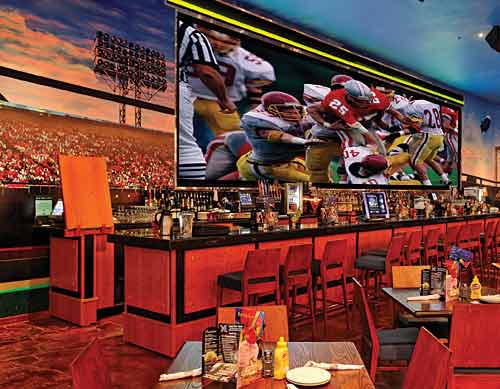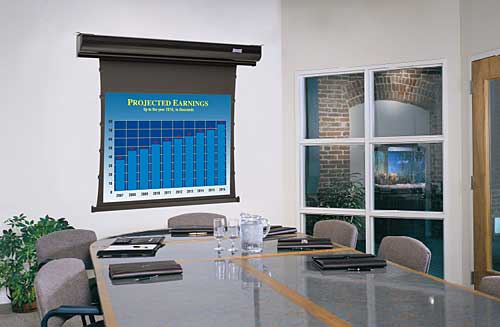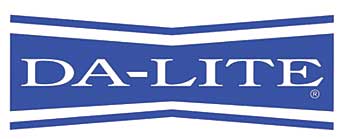Match Game: Specifying the Right Projection Screen for the Presentation Space
![]() Continuing Education
Continuing Education
Use the following learning objectives to focus your study while reading this month’s Continuing Education article.
Learning Objectives - After reading this article, you will be able to:
- Explain the steps to easily specify the right projection screen for the space.
- Discover how best to match the projection screen size to the material projected.
- Identify the relationship between projection output, the projection environment, and projection screens to ensure optimal viewing and comfort.
Conference rooms, classrooms, auditoriums, and theaters are spaces that are uniquely purposed for presentations. Quarterly reports, a lesson about the Spanish Inquisition, keynote speakers, and the latest Vince Vaughn or Meryl Streep movie each find its time to shine in these rooms specially designed to be a stage for the conveyance of information or entertainment. While architects are not responsible for ensuring that the material presented is accurate or even interesting, they are given the task of with making sure that every member of the audience can comfortably see and experience the presentation or performance.
The projection screen is a key component of a successful presentation space. Specifying a projection screen that does not fit the needs of the room can sink a presentation faster than a bad joke. When audience members are squinting in the back row or the people on the fringe are forced to crane their necks or contort their bodies to see the presentation, the space is working against the presenter. A misfit between the presentation and the available screen space can be equally as dismal. Evidenced by distracting black lines or blank space around the carefully prepared board presentation or by the projected image spilling off of the screen and onto the surrounding walls, specifying the right projection screen is of paramount importance to creating a functional presentation space.
To prevent these presentation snafus, the projection screen on the project should be specified in terms of size, surface, and physical characteristics.
The Best Screen Shape is Not a Square
In the beginning, projection screens were square. This original shape was due more to the available projection technology and less a result of what made sense in the space. Overhead projectors started gaining popularity at the end of World War II. Over the next 20 years, overhead projectors and their counterparts, the square screens, became common fixtures in classrooms and conference rooms throughout the United States. Teachers and presenters placed one square transparency at a time upon the glass plate, cranked the focus knob until the page slid into clarity on the square screen, and tried to keep their hand cool underneath the hot overhead light.
As projection technology advanced, every piece of the projection puzzle has been improved to create a better experience for the audience and establish projection as a more functional medium for communication. Projectors became smaller, lighter, brighter, and offered better resolution. A wider selection of formats now provide more options to best share the presentation or video with a captive audience. Better projection capabilities coupled with advances in software made it possible to use projection to display data as well as images.
|
All of these advancements in projection have had an interesting impact upon the shape and size requirements of the projection screens. Those original square projection screens have been replaced by a variety of rectangular screens. There are two reasons for this new shape. First, it is a better match for the natural visual field of the human eye, which is also rectangular (135 degrees by 160 degrees wide). Second, as the selection of formats has evolved, they have become steadily more rectangular or wide-screen. Instead of trying to display a rectangular image on a square screen, the market has modified the shape of the projection screens to offer clients and audiences a perfect match. It can be noted that the rectangular screen shape is a better match for the natural visual field of the human eye and the latest formats on the market.
Size Matters
The first step to ensuring that the space is an effective presentation forum where each member of the audience can see the presentation is to select a screen that is the right size. An appropriate screen size is determined by taking both the seating arrangement and dimensions of the room into consideration.
As the material projected has changed-from images to data-the guidelines for sizing a screen have been re-evaluated. A few years ago, the standard practice was to establish the width of the projection screen first. The width of the screen was determined by measuring the distance between the screen to the most distant viewer (MDV) and then dividing by six. Previously, projection screens just needed to be big enough for everyone to see, now they must be big enough for everyone in the space to read and evaluate, including the person sitting in the very back row on the outside edge of the room.
|
Today's sizing guidelines recommend that designers begin by determining the height dimension of the screen. The general rule for conference rooms and classrooms is that the screen height should be equal to one-sixth of the distance between the screen and the most distant viewer (MDV). The symbol height on the projection screen must increase one-fourth of an inch for every additional seven feet of viewing distance.
Once a screen height has been established based on the distance between the screen and the most distant audience member, it must be checked against the dimensions of the room. Another general rule for presentation spaces is that the bottom of the screen should be a minimum of 4 feet (48 inches) above the audience floor, allowing those audience members seated in the back of the room to see the entire screen. When specifying a screen onto a project, check to ensure that the suggested height of the screen plus the empty space below the bottom of the screen do not exceed the room's ceiling height.
Once the screen height is established, the width of the screen will be determined by the format of the information that will be projected and its associated aspect ratio. The aspect ratio is a ratio of width to height in which the material was recorded and will be projected.
Match the Appropriate Format
When starting a rental video, as the lights are dimming, the popular disclaimer, "This film has been modified from its original version," will dependably appear before the movie begins. This disclaimer exists because the video format of the movie about to be watched at home on a DVD player has been changed from the film format of the original production shown in the movie theater. Movies are recorded on film that is similar to the film in a still camera. This type of film employs chemical reactions to record the visual information on special material. This differs from video formats that store visual information as electronic signals that are then transmitted to the television via radio waves or coaxial cable.
The reason that format is important to consider when selecting a projection screen is that each format captures visual information in a different size or aspect ratio-the ratio of width to height. Movie film, for example, records images that are over twice as wide as they are high. Video formats that can be played on a standard television screen are almost square. In order to make the projected informationfit cleanly onto the available screen, the format of the projected material must match or fit inside of the dimensions of the projection screen.
Today, there are five common format types available, each with its own respective aspect ratio.
- The Cinemascope format is often the format in which movies are originally filmed. The native aspect ratio here is quite wide. It is 2.35:1, which means that in this format the picture is a little more than twice as wide as it is tall.
- The National Television Standards Committee (NTSC) video format is the format that was initially designed to fit cathode ray televisions and has been the standard broadcast format in the United States, Canada, Japan, and elsewhere since that technology first launched into the market. The aspect ratio for this format is 4:3 or 1.33:1, which means that the width of each picture is 1.33 times greater than the height. This aspect ratio is also referred to as a Full Screen format.
- The Letterbox video format attempts to fit the wide-screen image played in movie theaters into the full-screen format that is accepted by most standard televisions. The result is that the picture is pre- sented in the middle of the television screen with black bars above and below it. The problems with the Letterbox format are two-fold. First, the viewing area available on the television screen is significantly shrunk, which can make it difficult to see, and, second, many viewers are terribly distracted by the black bars above and below the image. It does, however, allow viewers to see everything that the director intended them to see on their standard format television screen. The aspect ratio of the Letterbox format is 1.85:1.
- The High-Definition Television (HDTV) video format allows movies to be played in their original wide-screen format without the black bars around the picture. This aspect ratio of 16:9 or 1.78:1 is also becoming a widely popular computer monitor size.
- The AV or square format refers to square screens. These non-standard aspect ratios do not match standard television screens or computer screen formats. Square screens should only be specified on a project where overhead transparency projectors are used.
There is a new format size popping up in computer monitors and in software platforms that boasts an aspect ratio of 16:10. This particular size allows users to clearly display pre-press materials two-up. To meet this new demand, projectors are being introduced onto the market with a native aspect ratio of 16:10. Projection screens built to this ratio are also readily available.
As explained earlier, the height of the projection screen should be determined first based on the distance between the screen and the most distant viewer. The width of the screen is then determined by applying the native aspect ratio of the projector or the aspect ratio of the format of the material that will be projected.
Selecting a Screen Surface
After the size of the projection screen has been determined, it is time to specify the surface of the screen. A successful projection is comprised of four separate elements: the projector, the projected material, the projection environment, and the projection screen. The projection requirements are determined by the projector, the projected material, and the projection environment. These requirements outline the situation in which the screen will need to perform. The viewing requirements describe the necessary performance specifications of the screen itself. The screen surface should be selected that best accommodates the projection requirements and meets the viewing requirements.
Projector Output
The power of any projector is measured in terms of the intensity of the light it produces. That light intensity is measured in lumens and, depending upon the lumens produced, projectors are classified as low output, moderate output, or high output projectors. All projectors have an output rating by the American National Standards Institute, which is commonly referred to as ANSI. Like horsepower on an engine, the higher the ANSI rating, the higher the light output from the projector. While there is no defined range for any of the output classifications, generally speaking, a projector measured between 700-1500 ANSI is considered low output. A moderate output projector attains a rating somewhere between 1500-3000 ANSI and any rating above 3000 ANSI would be considered a high output projector.
However, a higher output is not synonymous with a better image. The quality of the image produced also depends upon the size of the screen and the ambient light conditions paired with the projector. As an example, think of the light intensity from a projector like butter on a knife. The projection screen is a piece of bread. The light from the projector spreads out over the projection screen. The larger the screen, the thinner the layer of butter will be on the surface. In terms of projection images and light output, the larger the screen, the more spread out the light will be and the dimmer the image becomes. On the other hand, if the screen is too small to spread the light effectively, the image produced will be uncomfortably bright.
Material Projected
The material projected onto the screen in conference rooms, classrooms, auditoriums, and theaters typically falls into three categories: presentation material, video images, and polarized 3-D projection. Each category of material represents its own group of needs and
considerations when attempting to specify a screen that will maintain the integrity of the projected image.
Projectors do not produce the color black. Black is the absence of light and projectors produce light. Projection screens are not made in black. If they were, they would simply absorb the entire image projected at them instead of transmitting it or reflecting it back to the audience. This natural lack of black in projection technology reduces the contrast within the image on the screen, which can make the colors seem less vibrant. To improve the level of contrast on the screen, high-contrast fabrics are available. These high contrast fabrics are tinted gray. Adding gray to the screen tricks the human eye into seeing more contrast than was initially present. The grayscales appear darker, the whites brighter, and the colors more vibrant, which makes the image more impressive. These gray high-contrast screens are a good match for projecting video images, because the pictures are always moving, so the audience will not notice that the screen is gray.
|
These gray screens are not so inconspicuous when it comes to projecting presentation materials, like a spreadsheet or a word document that characteristically have white backgrounds. When the static image of a white spreadsheet is projected onto a gray screen, the image will look dirty and gray and it will sit there, dirty and gray, until the presenter moves to the next image, which hopefully was not built on a white background. When presentation material is the type of material that will be projected, it is best to specify a white screen. Never recommend high contrast material in a presentation type of application.
When projecting a polarized 3-D image, the projection screen will also need to be polarized to allow audiences to see the 3-D image. When specifying a polarized screen, it is important to know if the polarized images will be active, passive linear or passive circular. Then select the screen type designed to project that specific type of 3-D image.
Ambient Light Levels
Ambient light is the light present in a room that is not produced by the projector. Ambient light is composed of overhead electric lighting, natural light streaming in through the windows, and the reflections of that light in the space, for instance, off of light colored walls or reflective picture frames. The presence of ambient light has a significant impact on the amount of light output or type of projection screen that is
necessary to achieve an appropriate contrast between the projected image and its surroundings.
|
To determine the level of ambient light in a presentation or performance space, it is important to ask the people that will be using the space how they want to view the screen. In conference rooms and classrooms, most people prefer to leave the overhead lights on or faintly dimmed, so that employees or students can take notes or follow along in supporting materials during the presentation. In these presentation scenarios, a large amount of ambient light must be accommodated. In movie theaters, the lights are lowly dimmed and used primarily to illuminate stairs and exits. In these situations, ambient light is much less of an issue.
To describe the level of ambient light in a presentation space, rooms are often categorized as either dark rooms, which contain little or no ambient light, moderately lit rooms, or brightly lit rooms. As previously outlined, the light that a projector emits is measured in lumens. The light that is reflected or transmitted off of a projection screen is measured in lamberts. In order for the audience to see the projected image clearly, the minimum contrast ratio of the image reflected off of the screen in relationship to the screen's surrounding or ambient light level is approximately 5:1.
Reaching the appropriate contrast ratio can be accomplished a few different ways. First, the ambient light could be reduced by specifying materials that absorb light, such as dark fabrics or paint. Electric lights can be controlled with dimmers and window treatments could be specified to control the presence of natural light in the space.
If better control of the ambient light is not an option, then a projector with a higher output could be selected. Increasing the intensity of the light shot from the projector onto the screen will, subsequently, increase the brightness of the image reflected off of the screen. Shrinking the size of the projection screen will also improve the brightness of the image, but may make the screen too small to be viewed comfortably by the most distant viewer and, therefore, is not considered a viable option for maintaining an appropriate contrast ratio.
Viewing Angles
One of the performance specifications that architects will find on any projection screen is the viewing angle. The viewing angle is the maximum angle at which a display can be viewed with acceptable definition
-without being garbled, blurring, or too faint to see clearly. While designing a presentation space, it is important that the seats of the
audience all fall well within the viewing angles of the projection screen.
To envision a viewing angle, imagine that a member of the audience is sitting in line with the center of the projection screen. That viewer is considered on-axis. Now imagine that the projection screen represents one axis and a second axis is drawn from the center of the projection screen through the on-axis viewer, creating a right angle. If the screen specified for the project has a viewing angle of 60 degrees, then a 60 degree angle can be drawn to both the right and left of the center viewer. These two angles define what is commonly referred to as the viewing cone. No seats should be planned outside of the viewing cone, because the image that the people in those seats will have of the screen will be distorted.
Projection screens today are manufactured to offer a wide range of viewing angles. A 60-degree viewing angle is considered especially wide. A 45-degree viewing angle is considered moderate. A narrow viewing angle will measure about 30-degrees.
Uniformity, Resolution, and Gain
Three other important characteristics to consider when selecting a
projection screen are uniformity, resolution, and gain. Uniformity describes the consistency of the brightness of the screen. Uniformity
in a screen ensures that the projected image will not appear to have
patches that are brighter or darker, but will instead appear evenly
illuminated across the entire projection surface. Resolution refers to the screen's ability to display fine detail. Gain refers to the reflectivity of the screen and its ability to make the reflected image brighter than the output from the projector warrants by reducing the viewing angle of the image.
|
Physical Characteristics
After the height and the width of the screen has been identified, and the surface of the screen selected, the final step in specifying a projection screen is to decide upon the different physical characteristics of the screen. These characteristics need to match the particular needs or uses of the projection screen and the presentation space.
Front or Rear Projection
There are two projection methods: front projection and rear projection. Much like winds are named by the direction that they come from,
not the direction they are headed, so too, are projection methods. Front projection occurs when the projector is placed out in front of the
projection screen, as if it is a member of the audience. The projector shoots its visual image toward the projection screen, which then reflects the image back into the eyes of the audience. In front projection, the original image started in front of the projection screen.
In rear projection, the projector is positioned behind the projection screen. Instead of using the projection screen to reflect the image back into the audience, a rear projector transmits its visual message through the rear projection screen and into the audience.
Each of these projection methods has strengths and limitations. A brief compare and contrast of these two projection methods reveals that the real estate requirement is perhaps the largest difference between front and rear projection. In front projection, the projector sits in the same room as the audience, either perched on a conference table, on a cart in the middle of the room, or suspended overhead. Rear projection requires that a dark room exist behind the projection screen that provides enough room for the projector to project an image of the necessary size. The larger the image, the deeper the dark room must be to support it.
However, rear projection allows high-quality projection capabilities, without the clutter of the projector and the power cords out in plain sight. Rear projection also makes it impossible for the presenter to walk in front of the projection beam, nearly blinding himself or herself and blocking out the visual image in the process. Rear projection also manages ambient light better. A front projection screen cannot differentiate between the light from the projector and the light from overhead, it reflects all of it back into the eyes of the audience. With rear projection, the dark room behind the screen absorbs ambient light like a black box. The ambient light passes through the screen into the dark space, while the projected image passes through the projection screen into the auditorium, classroom, or conference room.
Electric or Manual Projection Screens
Most often the decision between selecting an electric projection screen and a manual projection screen is a matter of preference reserved for smaller screen sizes. When the screen size expands, for instance to 16' x 20', it is unreasonable to think that someone will reach over 16 feet into the air and pull it down.
Today, there are a variety of ways to control both the small and large projection screens electrically. It can be as simple as touching a button on the wall to lower and raise a projection screen; as convenient as a handheld infrared or radio frequency remote control; or as intricate as a fully integrated touch panel that also incorporates a sound system. With the most integrated solutions, it is possible to touch only one button to make the room presentation ready. The projector drops out of the ceiling, the projection screen descends from its recessed hiding place and the lights dim to a pre-selected level.
p>Wall-Mounted, Ceiling-Mounted, or Recessed
Mount projection screens on a wall or a ceiling for easy access and then tuck them away in their attached protective case when not in use. If the space demands something a little more discrete, projection screens can be easily recessed into the ceiling, completely removing it from the visual field when not being used.
There are a few applications that would not be a fit for a recessed ceiling mount. For example, recessing a projection screen in an application with an especially high ceiling, such as the sixty foot ceilings in some churches, is not an especially viable option. When the desired screen size is only a 9' x12', it does not make any sense to attach enough fabric to it to drop the projection screen to its desired position 30 feet below.
|
Portable or Fixed Frame
Is the projection screen being shared between multiple conference rooms or should it be an aesthetic fixture in the space? Both are
possible with today's technology.
Portable screens are now available with black backing. This black backing reduces the amount of light interference incurred from the other side of the screen, dramatically improving the quality of the image projected on these mobile presentation screens. The portable cases have also been made smaller and lighter so it is easier to move projection screens from one presentation to the next.
Fixed frames are good fits for rooms that host presentation after presentation and where the clients do not want to put the screen away. Mounted to a wall like a picture, this type of frame does not need to be hard-wired into the space like its electric counterparts. Fixed frames accommodate both front and rear projection methods.
Screen Borders
Human eyes focus better onto a particular image when it is bordered. Bordered images are also perceived to have more contrast, brighter colors, and be, overall, a sharper image. That fundamental feature of our visual system is responsible for frames around art and margins on paper. Borders around a projection screen also enhance the professionalism of the presentation by allowing the projected image to, in print terms, "bleed-off" of the screen.
To provide the best viewing environment for an audience, specify that black borders be included on the projection screens in the space. Without the clearly defined boundary of the screen, the images can get lost as audience members try to disseminate the edge of the fabric from the supporting wall behind the screen.
Drop
The term drop in the projection screen industry refers to extra fabric that is added to the top or bottom of the screen to position the screen surface within normal viewing heights. An example of when this may be used is in a building with high ceilings. If there is a 15 foot ceiling and a 6' x 8' projection screen is going to be mounted so that
the bottom of the screen is 4 feet or 48 inches off of the ground, the project demands 5 feet of drop to be added to the top of the screen
and mounted to the ceiling.
How To Specify a Projection Screen
The projector and the projection screen are undeniably a team, but when specifying a classroom, conference room, auditorium, or theater, which piece of equipment should be selected first? Approaching these presentation spaces in the following order can relieve headaches and technical misfits that may only be uncovered after the space is completed:
First, identify the height of the screen that will best fit the audience configuration and the dimensions of the room. Establishing the height of the projection screen first ensures that all audience members will be able to see the presentation comfortably.
Then, review the light conditions of the space. Determine the projector output (high, medium, or low) that will be necessary to maintain the target 5:1 contrast ratio between the brightness of the projection screen and its surrounding environment.
Next, examine which format will be the most appropriate for the type of information or entertainment presented. Select a projector that provides the level of output desired with a native aspect ratio that matches the appropriate format. Apply the recommended screen height to the selected aspect ratio in order to resolve the width of the screen. Select a screen surface that appropriately accommodates the projector output, projected material, and environment of ambient light, while providing the visual angles, uniformity, resolution, and gain required by the space.
Investigate how projection will be used in the space and specify the level of control-manual, electric, integrated-and the mounting type.
Last, but not least, specify black borders to frame the presentation screen and check to see if a drop is required.
|

